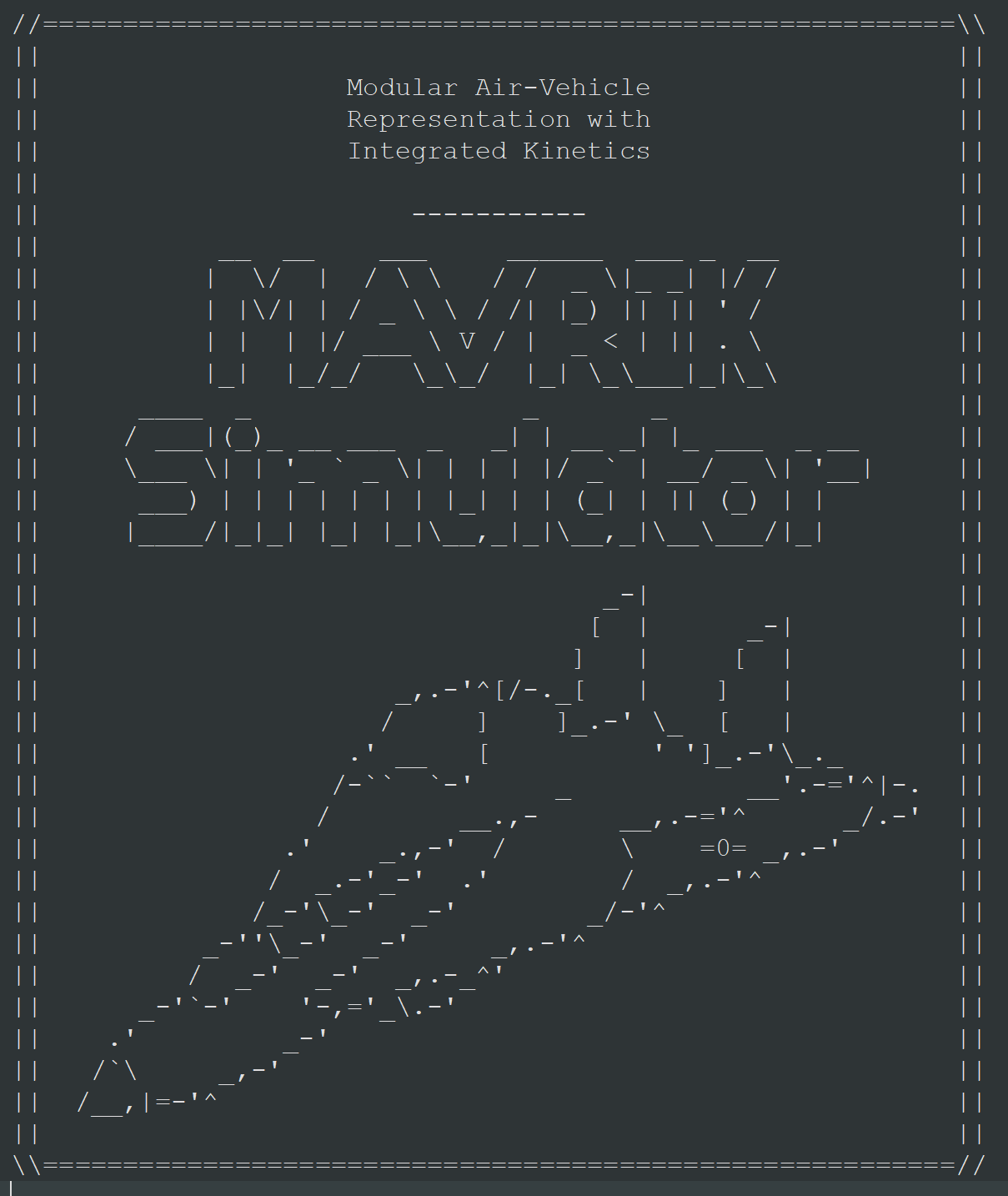Flight Simulation
Modular Air-Vehicle Representation with Integrated Kinetics
MAVRIK
About MAVRIK
MAVRIK is a versatile and robust flight simulation environment capable of predicting the aerodynamic and mass properties of an air vehicle using only simple geometric inputs. The simulator constructs each vehicle modularly, combining individual components composed of basic geometries. This modular approach enables rapid evaluation of flight characteristics and control laws across a wide range of vehicle configurations during early design phases.
While MAVRIK can automatically estimate aerodynamic and mass properties for concept evaluation, it is also highly customizable, allowing users to implement user-defined aerodynamic models, mass distributions, and inertia tensors. This flexibility makes MAVRIK suitable for every stage of vehicle development—from conceptual design to detailed high-fidelity simulation and flight testing.
Because MAVRIK’s modular structure extends into simulation, it supports real-time morphing and configuration changes during flight. Any component parameter—such as position, orientation, or geometry—can be defined as a function of state variables or pilot control inputs, enabling the simulation of shape-changing and adaptive aircraft.
MAVRIK can model a wide variety of morphing and dynamic platforms, including but not limited to:
Variable-sweep wings
Tilt-rotor and convertible VTOL aircraft
Vehicles with changing mass and inertia, such as solid rocket boosters
Pop-out and telescoping wing designs
Aerial refueling operations with evolving mass properties
Release of external stores (armaments, pods, or payloads)
Launched effects and vertical takeoff UAVs
By combining modularity, physical fidelity, and user extensibility, MAVRIK serves as a powerful tool for exploring and validating both conventional and unconventional air-vehicle concepts.
Key Features
MAVRIK is designed to provide a powerful, flexible, and modular simulation environment that supports rapid concept evaluation and high-fidelity aircraft modeling. Its architecture integrates automation, customization, and scalability—making it an essential tool for researchers, developers, and system integrators.
Modular Air-Vehicle Framework – Build aircraft from interchangeable geometric components for rapid configuration and analysis.
Automated Mass and Aerodynamic Modeling – Predict mass properties and aerodynamic behavior automatically from simple geometric inputs.
Preliminary Design Support – Evaluate flight characteristics and control laws early in the design cycle for faster development decisions.
Highly Customizable Aircraft Modeling – Incorporate user-provided aerodynamic and mass datasets for increased fidelity and flexibility.
Headless Operation – Run multiple simulations simultaneously for large-scale or automated test campaigns.
Comprehensive I/O Capability – Communicate via UDP or file-based interfaces for integration with data loggers, control software, graphics engines, and external systems.
Sensor Modeling and Noise Simulation – Accurately replicate sensor physics and noise characteristics for realistic system performance.
Actuator Dynamics – Optional first- and second-order actuator models enable more realistic control system simulations.
Real-Time and Faster-Than-Real-Time Execution – Suitable for both hardware-in-the-loop (HITL) testing and rapid simulation workflows.
Environmental Modeling – Includes optional spherical and ellipsoidal Earth representations with latitude and longitude tracking, as well as a standard atmosphere model with adjustable pressure and temperature offsets.
User-Friendly Input Formats – Configure simulations using intuitive JSON and CSV files.
Automatic Unit Handling – Seamlessly converts between SI and Imperial units throughout all model parameters.
Fully Customizable Control Effectors – Define and test any control surface or effector configuration.
Dynamic Component Properties – Enable in-flight parameter changes based on system state or control inputs, supporting morphing and adaptive aircraft.
Full 6-DOF Trim Solver – Compute trimmed flight conditions for multiple maneuver types.
State-Space Model Generation – Export linearized system models directly from nonlinear flight dynamics for control design and analysis.
Inputs
-
Input all necessary parameters into MAVRIK using simple, widely supported JSON and CSV file formats, making setup and configuration fast, transparent, and easily scriptable.
-
MAVRIK can automatically estimate the aerodynamic and mass properties of a vehicle based on its simple geometric definition, enabling rapid setup and early-stage analysis.
For higher-fidelity applications, users can import detailed aerodynamic databases from CFD or wind tunnel testing, along with mass and inertia properties derived from CAD models, allowing seamless transition from conceptual design to advanced simulation.
-
MAVRIK can be configured to receive control commands via UDP messaging, allowing seamless integration with your flight control software. Users can define the control update rate and specify whether the simulator should wait for incoming control data or continue running autonomously, enabling both real-time hardware-in-the-loop and open-loop simulation modes.
Outputs
-
MAVRIK can generate linear state-space matrices for your vehicle about any specified flight condition, providing a solid foundation for control law design and stability analysis—helping you get a head start on control development.
-
MAVRIK can be configured to record data logs to CSV files at customizable logging rates, capturing state variables, control inputs and commands, and sensor outputs for detailed analysis and post-flight evaluation.
-
MAVRIK can transmit emulated sensor data to your flight software via UDP messaging, with user-defined noise levels to replicate real-world conditions. Test your control system’s robustness against scenarios such as GPS signal loss, or evaluate performance using different IMU configurations and sensor accuracies.


